low oil pressure AUDI Q5 2013 Owners Manual
[x] Cancel search | Manufacturer: AUDI, Model Year: 2013, Model line: Q5, Model: AUDI Q5 2013Pages: 316, PDF Size: 78.89 MB
Page 30 of 316

28 Driver information d isplay
F or example, the symbol for a p roblem with
engine oi l pressure . appears i n the display .
The fo llow ing message appears:
Turn off engine! Oil pre ssure too low
The driver message in the display goes out af
ter about
5 seconds. The dr iver message ca n
b e d isp layed again by briefly pressi ng the
ISE Tlbut ton
r:::;, fig. 22.
Driver messages and yellow symbols
If a ye llow symbo l appears in the display, a
d river message is a lso displayed automat ica l
l y.
For example, the symbo,
(-$ appea rs in the
d isplay, ind icati ng low w indshield was her flu
id leve l. The follow ing message also appears:
Please refill washer fluid
The driver message disappears after a few
seconds . The driver message can be d isp layed
again by b rief ly pressing the !SET I button.
Red symbols
A red symbol means DANGER .
Fig . 2 3 Disp lay: Da nge r sy mbo l
" Pull off the road .
" Stop t he vehicle .
" Turn off the e ngine.
" Check the ma lf u nction ing system. Con ta ct
yo ur autho rize d Au di dea ler o r a q ua lified
wor kshop for assis tance .
Red symbols indicate a priority 1 ma lf u nction
- Danger!
W it h a pr iority 1 malfu nction, a red symbol
appears in the upp er center area of the dis- play
r:::;,
fig . 23. A drive r message ap pears as
well to exp lai n the ma lfunction in more de
ta il. When this symbol appears ,
three warning
tones so und in succession . T he symbo l contin
u es to flash unti l th e fault has been corrected.
If several priority 1 malfunctions are present,
the symbo ls appear in s uccession and rema in
for about
2 seconds.
The driver wa rning goes o ut after about
5 sec
onds, but it can be bro ught up aga in at any
t ime by press ing the ISET I button
r:!;> page 2 7 .
Alt ernator fa il ur e
r:!;> pag e 28
Electrom echanical steering
r:::;,page20 1
USA models: Brake system
malfunction
r:!;> page 29
Canada models: Brake sys
tem malfunction
r:::;,page29
En gine coolan t leve l too low/
e ngine coolant tempe rature
too h igh
c:::>page30
Eng ine oil pressure too low
c:::> page 30
Refill engine oil now
c:::> pag e 31
Stee ring malfunction
c:::> page 31
Ignition lock malfu nction
r:::;, page31
Hybrid drive *
r:::;,page 99, c;,page 105
E3 Alternator malfunction
If the . symbo l in t he instr ument pane l dis
play flashes, t hen t he re is a ma lfunction in t he
alternato r or the ve hicle elect ronics . A warn-
ing to the driver will appear, too. The driver
II>
Page 32 of 316
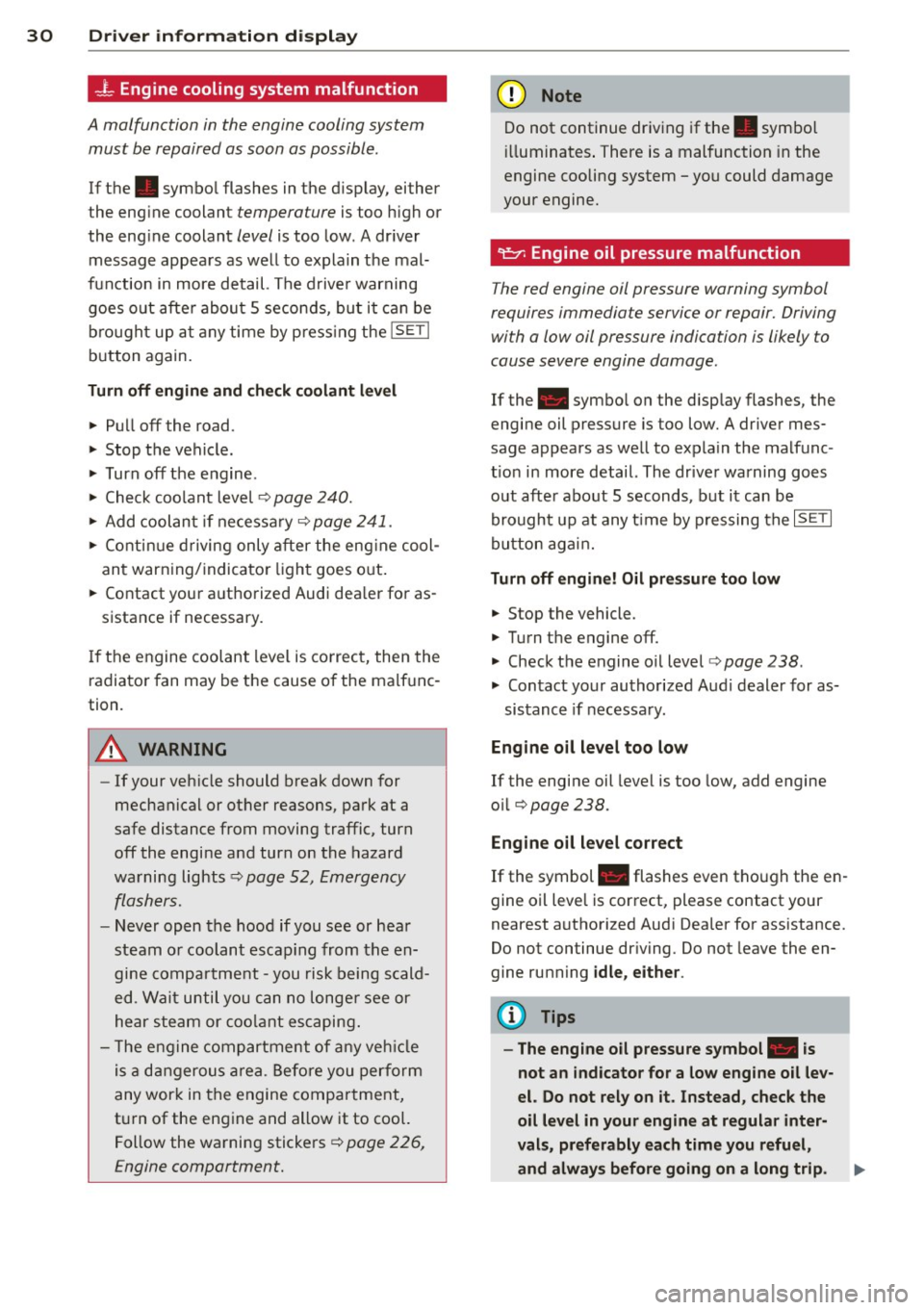
30 Driver in formation d isplay
...L Engine cooling system malfunction
A malfunction in the engine cooling system
must be repaired as soon as possible .
If the . symbol flashes in the display, either
t he eng ine cool ant
temperature is too h igh or
the eng ine coolant
level is too low . A dr iver
message appears as well to explain the mal
function in more detail. The d rive r warning
goes out afte r about 5 seconds, but it ca n be
b rought up a t any time by p ress ing the
!SE TI
button again.
Turn off engine and ch eck coolant l evel
• Pull off the road .
• Stop the vehicle .
• Turn off the engine.
• Check coo lant level¢
page 240.
• Add coolant if ne cessa ry ¢ page 241 .
• Co ntin ue d riving only after the eng ine cool
ant warn ing/ indicato r light goes o ut.
• Contact your a uthorized Audi dea ler for as-
sistance if necessary.
If the engine coolant level is co rrec t, then the
radia tor fan may be the cause o f the malf unc
tion .
A WARNING
-If your veh icle should break down for
mechanical or other reasons, park at a
safe distance from moving traffic, turn off the engi ne and turn on the hazard
wa rning lights ¢
page 52, Emergency
flash ers.
-
- Never open the hood if you see or hea r
steam o r coolant esca ping from the en
gine compa rtme nt - you risk being s cald
ed. Wait until you can no longe r see or
hear steam or coo lant es caping.
- T he e ngine compartmen t of a ny veh icle
is a dan gerous area. Before you perform
any wor k in the engine compartment,
t ur n of the engine and allow it to coo l.
Follow the wa rning stickers ¢
page 226,
Engine compartment.
(D Note
Do not continue driv ing if the . symbo l
ill um inates . There is a mal function in the
engine cooling system -you could damage
your engine.
"l:::r. Engine oil pressure malfunction
T he red engine oil pressure warning symbol
requires immediate service or repair. Driving with a low
oil pressure indication is likely to
cause severe engine damage .
If the . symbo l on the disp lay flashes, the
engine oil pressure is too low. A driver mes
sage appears as we ll to exp la in the malfunc
t io n in more detail. The dr iver warning goes
o ut afte r abo ut 5 seconds , but it can be
brought up at any t ime by p ressing the
~ 1s =ET= I
button ag ain.
Turn off engin e! O il pressure too low
• Stop the vehicle.
• Turn the engine off.
• Chec k the engine o il level ¢
page 238 .
• Contact yo ur au thorized Aud i deale r for as-
sistance if necessa ry.
Eng ine oil level too low
If the engine oil level is too low, add engine
o il
¢page 238.
Engine oil leve l correct
If the symbol . flashes even tho ugh the en
gine oil leve l is correct, please contact your
nearest authori zed Aud i Dea ler for assistance.
Do not continue dr iving . Do not leave the en
gine running
idle, either .
(D Tips
- The engine oil pressure symbol. is
not an indicator for a low eng ine oil lev
e l. Do not rely on it. Instead, check the
oil level in your engine at regular inter
vals, preferably each time you refuel, and always before going on a long trip .
Page 33 of 316
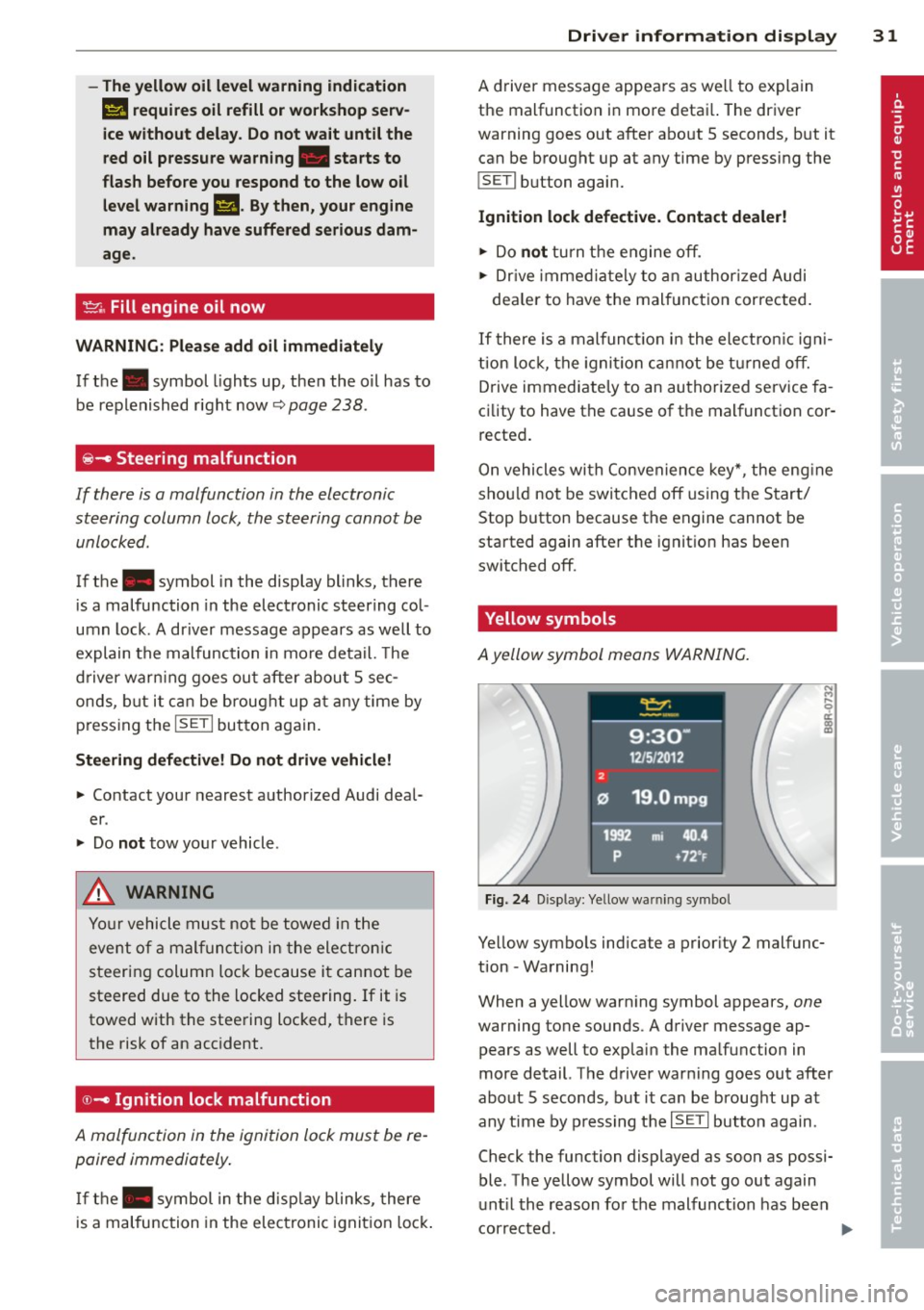
-The yellow oil level warning indication
II requires oil refill or workshop serv
ice without delay. Do not wait until the
red oil pressure warning. starts to
flash before you respond to the low oil
level warning
11-By then, your engine
may already have suffered serious dam
age .
~ . Fill engine oil now
WARNING: Please add oil immediately
If the . symbol lights up, then the o il has to
be re plenished r ight now ~
page 238 .
~- Steering malfunction
If there is a malfunction in the electronic
steering column lock, the steering cannot b e
unloc ked .
If the . symbol i n the display blinks , th ere
i s a malfunction in the electronic steer ing col
u m n lock . A driver message a ppears as well to
e xplain t he malfu nction in m ore deta il. The
d river war ning goes ou t a fter abou t
5 se c
on ds, but it can be brough t up at an y time by
p ress ing t he
ISE TI but ton again.
Steering defective! Do not drive vehicle!
.,. Co ntact your nearest authorized Audi deal
er .
.,. Do
not tow yo ur vehicle .
A WARNING
Your vehicle must not b e towe d in th e
eve nt of a m alfu nction in the ele ctronic
s t eerin g colum n lo ck bec ause i t ca n not be
steered due to the l ocked steering . If it is
towed with the stee ring loc ked, t here is
the risk of an accident.
© -Ignition lock malfunction
A mal function in the ignition lock mus t be re
paired immediately .
If th e. symbol in the d isp lay blink s, there
i s a ma lfunc tion in the elec troni c ignition lo ck.
Driver information display 31
A dr iver message appea rs as we ll to ex plain
t h e malfunction i n mo re deta il. The dr iver
warning goes out after a bout 5 seconds, b ut it
can be b roug ht up at any time by pressing the
ISE TI b utt on again.
Ignition lock defective. Contact dealer!
.,. Do not tu rn th e e ngine o ff.
.,. Drive imme diate ly to an a uthor ized A udi
dea le r to have t he mal funct io n corrected .
If there is a mal fun ctio n in t he ele ct ro nic igni
tio n loc k, the igni tion can not b e turne d off.
Drive immediate ly to an au tho riz e d se rvice fa
c ili ty to have t he cause of t he malfunct ion cor
r ected .
On vehicle s wi th Conven ien ce key* , the eng ine
s h ould not b e swi tc h ed off usin g th e S tart/
Stop button because t he engine cannot be
started again afte r th e ignit io n has been
switc hed off.
· Yellow symbols
A yellow symbol me ans WA RNING .
Fig. 24 Display: Yellow wa rning symbo l
N ..,
I
Yellow symbo ls ind icate a prior ity 2 malfunc
tion -Wa rning!
When a yellow warn ing symbol appears,
one
warning to ne sounds . A d river message ap
p ears as well to exp lai n the ma lfu nction in
m ore d etail. T he d rive r war ning goes out aft er
abo ut 5 seconds, but it ca n be broug ht up a t
any ti me by press ing t he
ISE TI button again .
Check the function displayed as s oon as possi
ble. The yellow symbol will not go out again
u nti l th e re ason fo r the mal func tion has bee n
cor rected.
Page 34 of 316
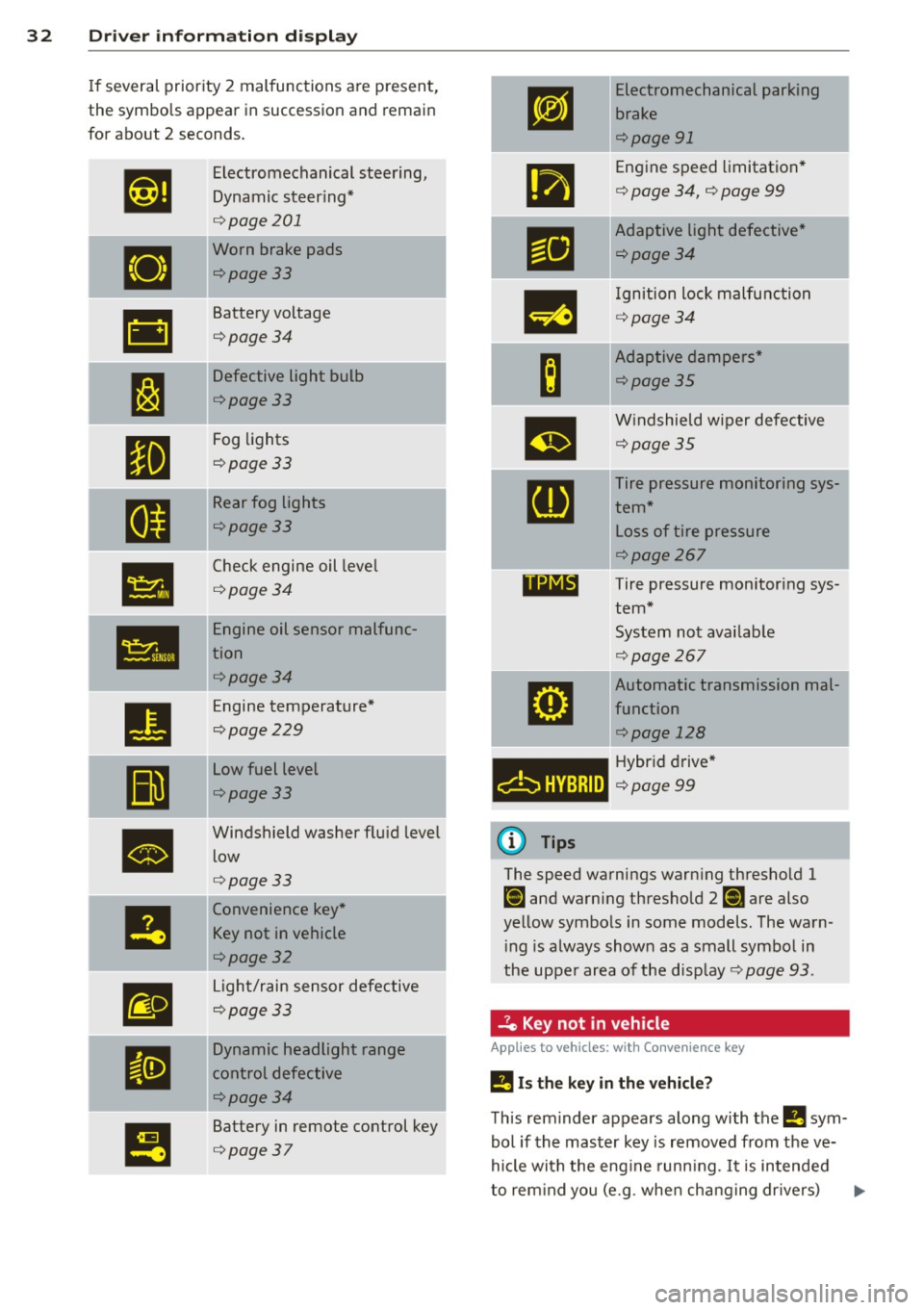
32 Driver in formation d isplay
If several priority 2 malfunctions a re present,
the symbols appear in succession and remain
for about 2 seconds .
,1,ij
Electromechanical steering,
Dynamic steering*
¢ page 201
•
Worn brake pads
¢page 33
&1
Battery voltage
¢page34
;....
J:J
Defective light bulb
¢page33
II
Fog lights
¢page 33
.... -
II
Rear fog ligh ts
¢page33
•
Check engine oil leve l
¢page34
Ill
Engine oil sensor malfunc-
tion
¢page34
•
Engine temperature*
¢page229
II
Low fuel level
¢page33
•
Windshield washer flu id level
low
¢ page33
!I
Convenience key *
Key not
in vehicle
¢page32
m
Light/rain sensor defective
¢page33
II
Dynamic headlight range
control defective
¢page34
I!
Battery in remote control key
¢ page 37
-
rm
.,
-
Ill
m
B
m
[DJ
11NIB
6HVBRID
(D Tips
E
lectromechanical parking
bra ke
¢page 91
Engine speed limitation *
¢ page 34, ¢ page 99
Adaptive light defective *
¢page34
Ignition lock malfunction
¢ page34
Adaptive dampers *
¢page35
Windshield wiper defective
¢page35
Tire pressure monitoring sys
tem*
L oss of tire pressure
¢page267
Tire pressure monitor ing sys
tem*
System not avai lab le
¢ page 267
Automatic transmission mal-I
function
¢page 128 j
Hybr id dr ive *
¢page99
The speed warnings warn ing thresho ld 1
Ct] and warning thresho ld 2 [i] are also
yellow symbo ls in some models . The warn
i ng is always shown as a small symbo l in
the upper a rea of the display ¢
page 93.
.Je Key not in vehicle
Applies to veh icles: w ith Convenience key
!I Is the key in the vehicl e?
Th is rem inder appears along with the !I sym
bo l if the master key is removed from the ve
hicle with the eng ine runn ing. It is intended
to rem ind you (e.g . whe n ch ang ing dr ivers) .,.
Page 86 of 316
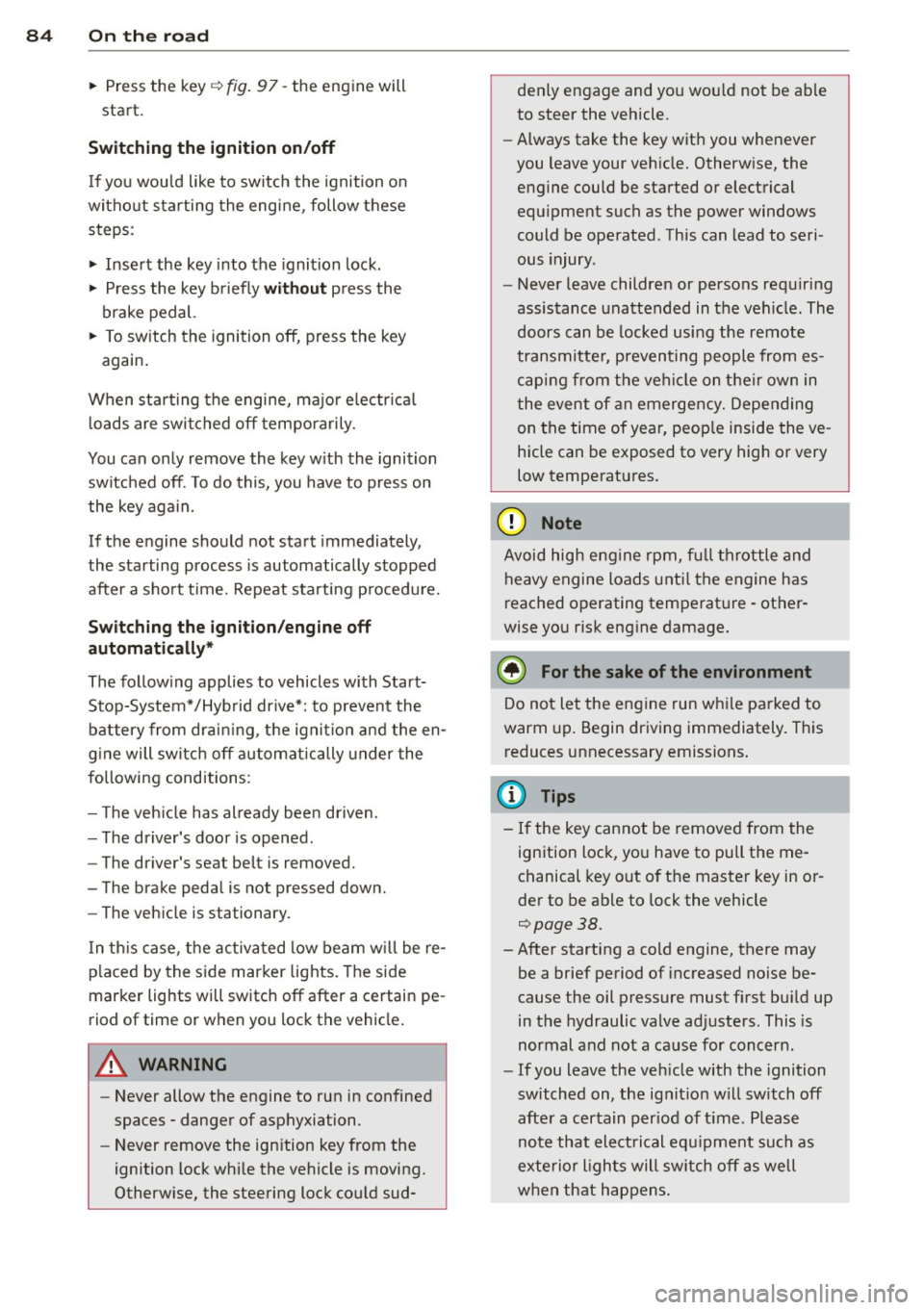
84 On th e road
• Press the key ¢fig . 97- the engine will
start.
Switching the ignition on /off
If you wou ld like to switch the ignition o n
without starting the eng ine, follow these
steps:
• Insert the key into the ignition lock.
• Press the key b riefly
w itho ut press the
brake pedal.
• To switch the ignition off, press the key
again .
When starting the engine, major e lectr ica l
loads are switched off temporarily.
You can only remove the key w ith the ignition
switched off. To do this, you have to press on
the key aga in.
If the engine should not start immediately,
the starting process is automatically stopped
after a sho rt time. Repeat starting procedu re.
Sw it c hing the ignition /engine off
automatically *
The following applies to vehicles with Start
Stop-System* /Hybrid drive*: to prevent the
battery from drain ing, the ignit ion and the en
g ine will switch off automatically under the
following conditions :
- T he veh icle has al ready bee n driven .
- The driver's door is opened .
- The driver's seat belt is removed.
- The brake peda l is not pressed down.
- The veh icle is stationary.
I n th is case, the activated low beam w ill be re
p laced by the side marker lights. The side
marker lights will switch off after a certain pe
riod of time or w hen you lock the vehicle .
A WARNING
-Never allow the engine to run in confined
spaces - danger of asphyxiation .
- Never remove the ign ition key from the
ignition lock while the vehicle is moving.
Otherw ise, the steering lock could sud- denly engage and yo
u wo uld not be able
to steer the vehicle .
- Always take the key with you whenever
you leave your vehicle. Otherw ise, the
engine could be started or electrical
equ ipment such as the power windows
could be operated. This can lead to seri
ous injury.
- Never leave children or persons requiring
assistance unattended in the vehicle . The
doors can be locked using the remote
transmitte r, prevent ing people from es
caping from the ve hicle on t heir own in
t he event of an emergency. Depending
on the time of year, peop le inside the ve
hicle can be exposed to very high or very
low tempe ratu res .
(D Note
Avoid high eng ine rpm, f ull throttle and
heavy engine loads unti l the engine has
r eached operating temperat ure - ot her
wise yo u risk eng ine damage.
@ For the sake of the environment
Do not let the engine run wh ile pa rked to
warm up. Begin driving immediately. This
r educes unnecessary emissions .
(D Tips
-If the key cannot be removed from the
ignition lock, you have to pull the me
chanical key out of the master key in or
der to be able to lock the vehicle
¢page 38.
-After starting a cold engine, there may
be a brief period of increased noise be
cause the oil pressure must f irst bu ild up
in the hydraulic valve adjusters . This is
normal and not a cause for concern.
- If you leave the ve hicle with the ignition
switched on, the ignit io n w ill switch off
afte r a certain per iod of t im e. Please
note that ele ctri cal eq uipment su ch as
exterior l igh ts will sw itch off as well
when that happens .
Page 89 of 316
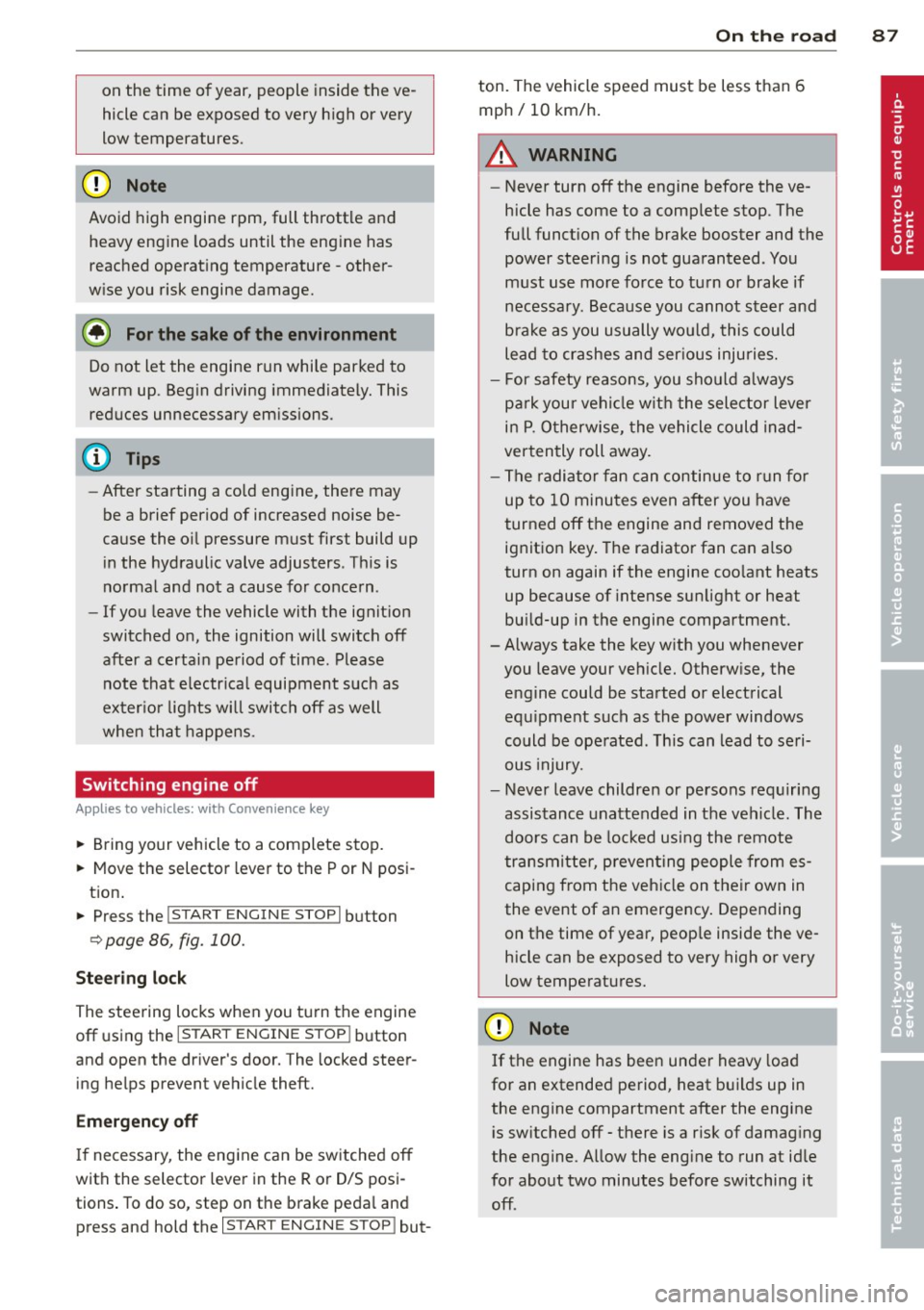
on the time of year, people inside the ve
hicle can be exposed to very high or very
low temperatures .
0 Note
Avoid high engine rpm, full throttle and
heavy engine loads until the engine has
reached operating temperature -other-
wise you risk engine damage.
@ For the sake of the environment
Do not let the engine run while parked to
warm up . Begin driving immediately. This
reduces unnecessary emissions.
@ Tips
- After starting a cold engine, there may
be a brief period of increased noise be
cause the oil pressure must first build up in the hydraulic valve adjusters . This is
normal and not a cause for concern .
- If you leave the vehicle with the ignition
switched on, the ignition will switch off
after a certain period of time . Please
note that electrical equipment such as
exterior lights will switch off as well
when that happens .
Switching engine off
App lies to vehicles: with Conve nie nce key
"" Bring your vehicle to a complete stop.
... Move the selector lever to the P or N posi
tion.
"" Press the
!START ENGINE STOPI button
r:::;, page 86, fig. 100 .
Steering lock
The steering locks when you turn the engine
off using the
I S TAR T ENGINE STOP I button
and open the d river 's doo r. T he locked steer
ing helps prevent vehicle theft.
Emergency off
If necessary, the engine can be switched off
with the selector lever in the R or D/S posi
tions. To do so , step on the brake pedal and
press and hold the
I START ENGINE STOP I but-
On the road 87
ton. The vehicle speed must be less than 6
mph/ 10 km/h.
A WARNING
- Never turn off the engine before the ve
hicle has come to a complete stop . The
full function of the brake booster and the power steering is not guaranteed . You
must use more force to turn or brake if
necessary . Because you cannot steer and
brake as you usually would, this could
lead to crashes and serious injuries.
- For safety reasons, you should always
park your vehicle with the selector lever
in P . Otherwise, the vehicle could inad
vertently roll away.
- The radiator fan can continue to run for
up to 10 minutes even after you have
turned off the engine and removed the ignition key. The radiator fan can also
turn on again if the engine coolant heats
up because of intense sunlight or heat
build-up in the engine compartment.
- Always take the key with you whenever you leave your vehicle. Otherwise, the
engine could be started or electrical
equipment such as the power windows
could be operated. This can lead to seri
ous inJury.
- Never leave children or persons requiring
assistance unattended in the vehicle. The
doors can be locked using the remote
transmitter, preventing people from es
caping from the vehicle on their own in
the event of an emergency. Depending
on the time of year, people inside the ve hicle can be exposed to very high or very
low temperatures.
(D Note
If the engine has been under heavy load
for an extended period, heat builds up in
the engine compartment after the engine is switched off -there is a risk of damaging
the engine. Allow the engine to run at idle
for about two minutes before switching it
off .
Page 203 of 316

Fa u lts in th e brake sy stem
If you should notice a sudden increase in
brake peda l travel, then one of the two brake
circuits may have failed~.&. .
Low brak e flu id level
Malfunct ions can occur in the brake system if
the brake fl uid leve l is too low . T he b rake fluid
l eve l is monito red electronically .
Brake booster
The brake booster increases the pressure that
you generate w ith the brake pedal.
It only op
e rates while the eng ine is running or with the
i gnit ion sw itched on (hybr id dr ive*) ~.&, .
Brake lining wear statu s
Brake lining wear may be checked by visual in
spection of the condition of the brake pads
through the openings in the whee l. If neces
sa ry, the wheel may be removed for this in
spection
~ page 2 74, Changing a wheel.
.&_ WARNING
=
- You should perform braking maneuvers
for the purpose of clean ing the brake
system on ly if road conditions permit.
Other road users must not be put at risk -
you may cause an acc ident!
- Before descending a steep grade, reduce
speed and shift transmiss ion into a lower
gear or lower driving range . Do not ride
the brakes or hold the pedal down too long or too often . This could cause the
brakes to get hot and dimin ish b raking
efficiency .
- Do not "ride the brakes" by resting your
foot on the pedal when you do not intend
to brake . Th is may cause the b rakes to
overheat, premat ure wear and increased
stopping distance .
- Under certain climat ic and operating
condit ions such as passing through wa
ter , driving in heavy rain or after wash ing
the vehicle, the effectiveness of the brakes can be reduced. In winter, ice can
accumulate on the brake pads, linings,
discs and drums . Carefully apply brakes
Int ellig ent technolog y 201
for a test. Brakes will dry and ice coat
ings w ill be cleaned off after a few care
ful brake applicat ions.
- Driving for an extended period of time on
salt-covered roads without using your
brakes can also affect braking efficiency.
Clean off accumulated salt coating from
brake discs and pads with a few careful
brake applications.
- If you damage the front spoiler, or if you install a different spoiler, be sure the air
f low to the front brakes is not obst ruct
ed. Otherw ise the brake system could
overhea t reducing the effectiveness of
the entire brake system .
- Failure of one brake circuit will impair
the braking capability resulting in an in
creased stopping distance . Avoid driving
the vehicle and have it towed to the near
est a uthori zed Audi dea ler or qualified
workshop.
- Never let the vehicle roll to a stop with
the engine shut off .
- If the brake booster is not working, for
examp le when towing your vehicle, or
because the brake booster has somehow
been damaged, the brake pedal must be
pressed considerably harder to make up
for the lack of booster assistance .
Electromechanical
power assist, Dynamic
steering
The electromechanical power assist helps the
driver when s teering.
Power ste ering adapts electronically based on
the vehicle speed.
Indicator lights an d m ess age s
• Steeri ng defe ctive ! D o n ot dr ive vehi cle!
If this indicator light turns on and stays on
and this message appears, the power steer ing
may have failed .
Stop the vehicle in a safe location as soon as poss ible . Do
no t continue driving . See your ..,.
•
•
Page 220 of 316
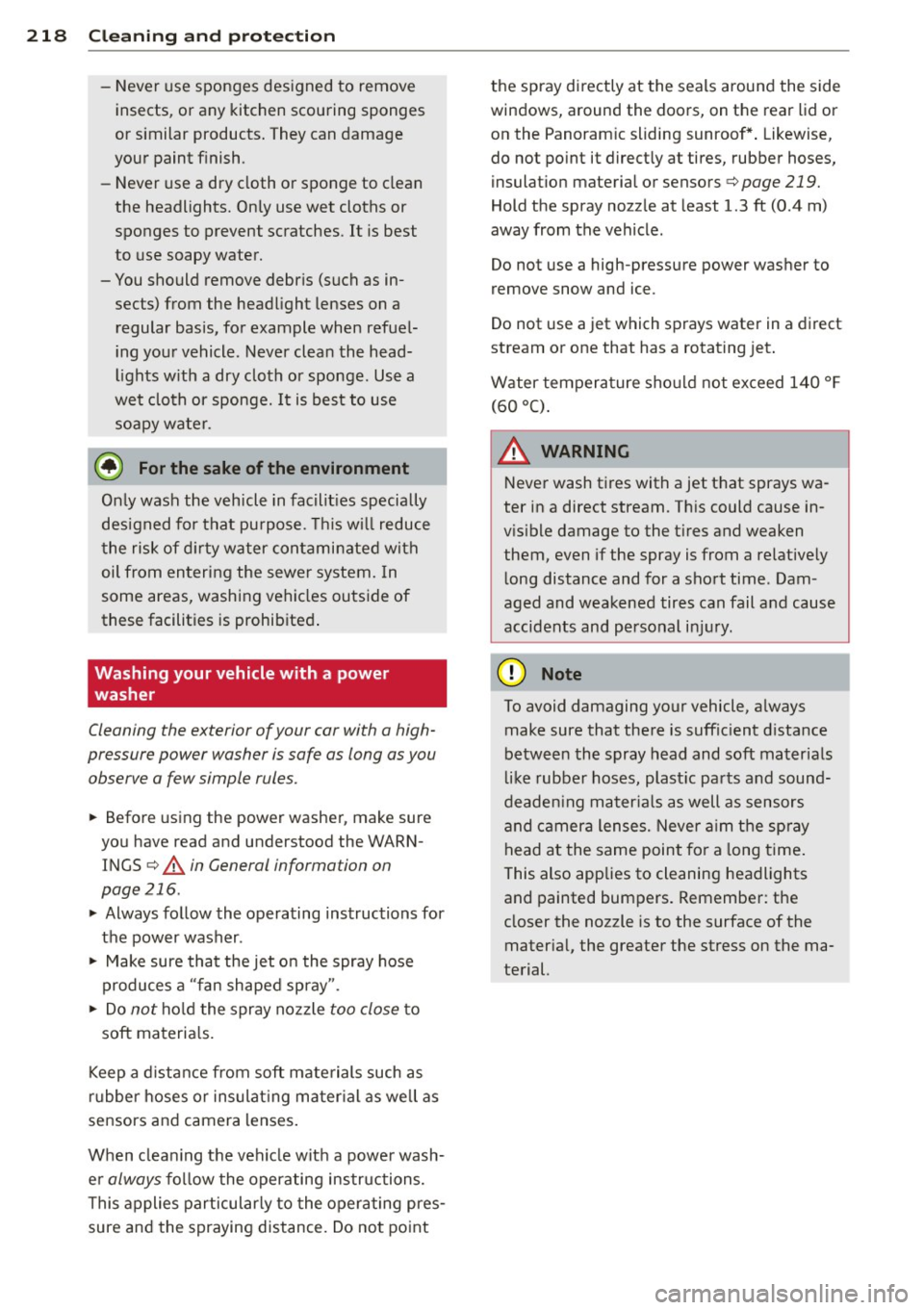
218 Clea ning and protec tio n
- Never use sp onges designed to remove
insects, or a ny kitchen scouring sponges
or similar products . They can dama ge
you r paint f inish.
- Never use a dry cloth or s ponge to clean
the headligh ts. On ly use wet clot hs or
sponges to prevent scratches.
It i s best
to use soapy water.
- You should rem ove debris (suc h as in
sects) from the headlight lenses on a
regular basis, fo r example when refuel
i ng your vehicle. Never clean the head
li ghts w ith a dry cloth or sponge. Use a
wet cloth or sponge.
It is best to use
soapy water.
@ For the sake of the environment
On ly wash the vehicle in facilit ies specially
designed for that pu rpose. This w ill reduce
t he risk of d irty water contami nated with
oil from en tering the sewer system. In
some areas, washing vehicles outside of
these facilities is prohibited .
Washing your vehicle with a power
washer
Cleaning the exterior of your car with a high
pressure power washer is safe as long as you
observe a few simple rules.
.. Before us ing the power washe r, make sure
you have read and understood the WARN
INGS¢
A in General information on
page 216 .
• Always follow the operating instructions for
the power washer .
• Make sure that the jet o n the spray hose
produces a "fan shaped sp ray ".
• Do
not ho ld the spray nozzle too close t o
soft materia ls.
Keep a d istance from soft mate rials such as
rubber hoses or insulat ing mater ial as well as
sensors and camera lenses .
When clea ning the veh icle w it h a power wash
e r
always fo llow the operating instructions.
This applies particul arly to the operating pres
sure and the spraying distance. Do not po int the spray di
rectly at the seals around the side
windows, around the doors, on the rear lid or
on the Panoram ic sliding sunroof* . Likewise,
do not po int it direct ly at tires, rubber hoses,
insulat ion material or sensors
¢ page 219.
Hold the spray nozz le at least 1.3 ft (0.4 m)
away from the vehicle.
Do not use a high-pressure power washer to
remove snow and ice .
Do not use a jet which sprays water in a direct
stream or one that has a rotating jet .
Water tempera ture sho uld no t exceed 140 ° F
(60 °().
_& WARNING
Neve r wash tires with a jet t hat sprays wa
ter in a direct stream . Th is could cause in
v is ible damage to the t ires and weaken
them, even if the spray is from a relative ly
l ong distance and for a short time. Dam
aged and weakened tires can fail and cause
accidents and personal in ju ry .
(D Note
To avoid damaging you r vehicle, always
make sure that there is suffic ient d istance
between the spray head and soft materia ls
l ike rubber hoses, plast ic pa rts and sound
deade ning mater ia ls as well as sensors
and camera lenses. Never a im the sp ray
head at the same point fo r a long time .
This also applies to cleaning headlights
and painted bumpers. Remembe r: the
closer the nozzle is to the surface of the
mater ia l, the greater the stress on the ma
terial.
Page 243 of 316
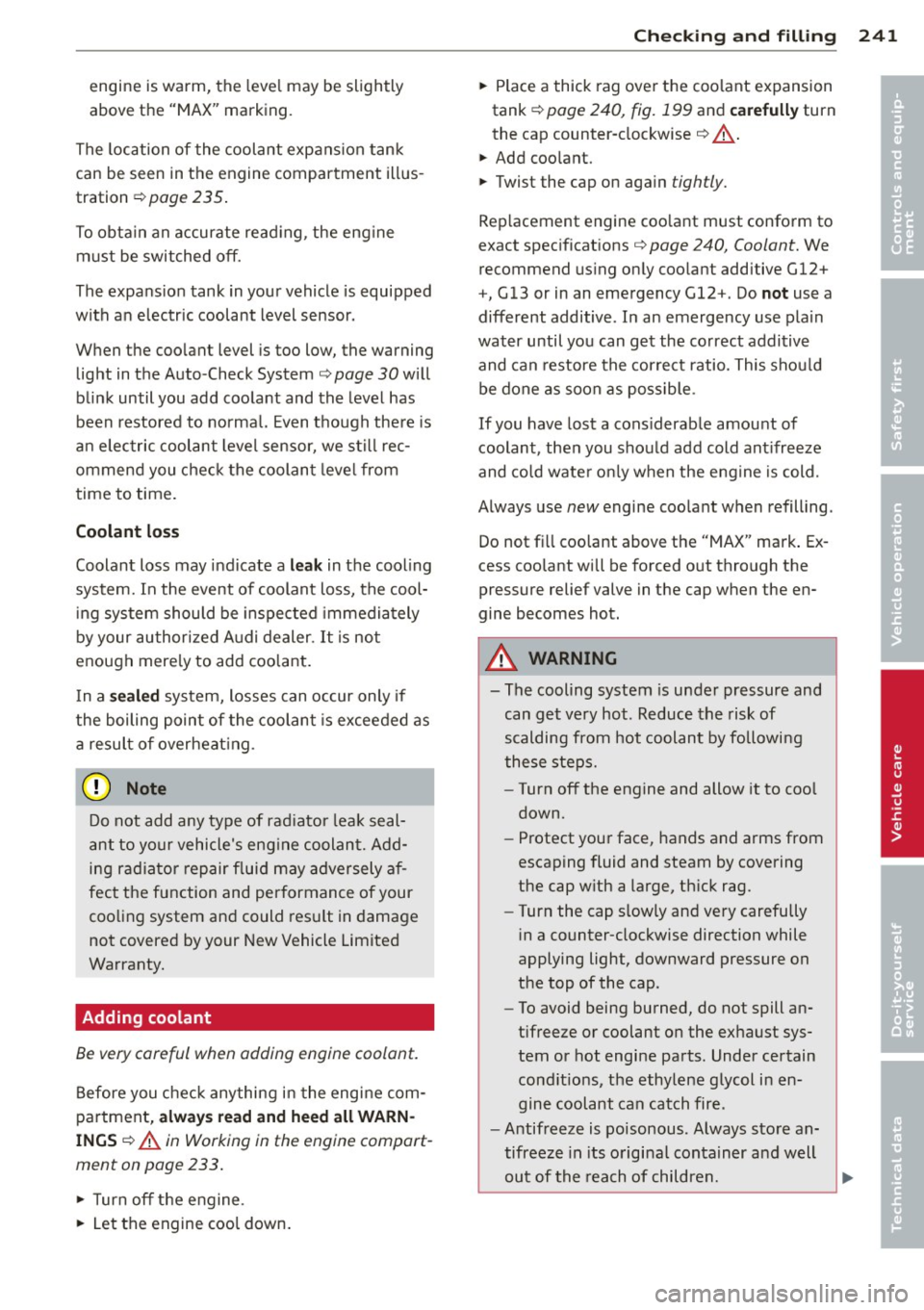
engine is warm, the level may be slightly
above the "MAX" marking .
The location of the coolant expansion tank
can be seen in the engine compartment illus
tration ¢
page 235.
To obtain an accurate reading, the engine
must be switched
off.
The expansion tank in your vehicle is equipped
with an electric coolant level sensor.
When the coolant level is too low, the warning
light in the Auto-Check System¢
page 30 will
blink until you add coolant and the level has
been restored to normal. Even though there is
an electric coolant level sensor, we still rec
ommend you check the coolant level from
time to time.
Coolant loss
Coolant loss may indicate a leak in the cooling
system. In the event of coolant loss, the cool
ing system should be inspected immediately
by your authorized Audi dealer.
It is not
enough merely to add coolant.
In a
sealed system, losses can occur only if
the boiling point of the coolant is exceeded as
a result of overheating.
(D Note
Do not add any type of radiator leak seal
ant to your vehicle's engine coolant. Add
ing radiator repair fluid may adversely af
fect the function and performance of your
cooling system and could result in damage
not covered by your New Vehicle Limited
Warranty.
Adding coolant
Be very careful when adding engine coolant.
Before you check anything in the engine com
partment,
always read and heed all WARN
INGS ¢ A in Working in the engine compart
ment on page 233.
... Turn off the engine .
... Let the engine cool down.
Checking and filling 241
... Place a thick rag over the coolant expansion
tank ¢
page 240, fig. 199 and carefully turn
the cap counter-clockwise ¢
A.
... Add coolant.
... Twist the cap on again
tightly.
Replacement engine coolant must conform to
exact specifications ¢
page 240, Coolant. We
recommend using only coolant additive
Gl2+
+, Gl3
or in an emergency Gl2 +. Do not use a
different additive . In an emergency use plain
water until you can get the correct additive and can restore the correct ratio. This should
be done as soon as possible .
If you have lost a considerable amount of
coolant, then you should add cold antifreeze
and cold water only when the engine is cold.
Always use
new engine coolant when refilling.
Do not fill coolant above the "MAX" mark. Ex
cess coolant will be forced out through the
pressure relief valve in the cap when the en
gine becomes hot.
A WARNING
- The cooling system is under pressure and
can get very hot. Reduce the risk of
scalding from hot coolant by following
these steps.
- Turn
off the engine and allow it to cool
down.
- Protect your face, hands and arms from
escaping fluid and steam by covering
the cap with a large, thick rag.
- Turn the cap slowly and very carefully
in a counter-clockwise direction while
applying light, downward pressure on
the top of the cap .
- To avoid being burned, do not spill an
tifreeze or coolant on the exhaust sys
tem or hot engine parts. Under certain
conditions, the ethylene glycol in en
gine coolant can catch fire.
-Antifreeze is poisonous. Always store an
tifreeze in its original container and well
out of the reach of children.
~
•
•
Page 250 of 316

248 Tire s and whee ls
Tires and wheels
Tires
General notes
Tires may be the least appreciated and most
abused parts of a motor vehicle .
Tires may be the least appreciated and most
abused parts of a motor vehicle. Tires are,
however, one of the most important parts of a
vehicle, particularly considering the compara
tive ly small patch of rubber on each tire that
assures that all -important contact between
you, your vehicle and the road.
Maintaining the correct tire pressure, making
sure that your vehicle and its tires do not have
to carry more weight than they can safe ly han
d le, avoiding damage from road hazards and
reg ularly inspecting t ires for damage includ
ing cuts, slashes irregu la r wear and overall
condition are the most important things that
you can do to he lp avoid sudden tire failure in
cluding tread separation and blowouts.
A vo idin g dama ge
I f you have to drive over a curb or similar ob
stacle, drive very slow ly and as close as possi
ble at a right angle to the curb.
A lways keep chem icals including grease, oil,
gasoline and b rake fluid off the tires.
Inspect the tires regularly for damage (cuts,
cracks or bl isters, etc.). Remove any foreign
bod ies embedded in the treads.
St orin g tire s
Mark tires when you remove them to indicate
the direction of rotation . Th is ensures you to
be ab le to mount them correctly when you re
install them.
When removed, the wheels or tires should be
stored in a cool, dry and preferably dark place .
Store tires in a vertical position if they are not mounted on rims, in a horizontal position if
they are mounted on rims. N
ew tir es
New t ires have to be broken in¢&,. .
The tread depth of new t ires may vary, accord
ing to the type and make of t ire and the tread
pattern .
Hidden damag e
Damage to tires and r ims is often not readily
vis ible . If you notice unusual vibrat ion or the
vehicle pulls to one s ide, th is may ind icate
that one of the t ires has been damaged . T he
t ir es must be checked immed iate ly by an au
tho rized Aud i dea le r or q ualified wor kshop.
Unidirecti onal t ires
A un idirectional tire can be identified by ar
rows on the sidewall, that po int in the direc
t ion the t ire is designed to rotate. You must
fol low the specified direction of rotation . This
is necessary so that these tires can develop
their optimum characteristics regarding grip, road noise, wear and hydrop laning resistance.
For more information ¢
page 2 78.
A WARNING
-New tires or tires that are old, worn or
damaged cannot provide maximum con
trol and braking ability .
-
-New tires tend to be slippery and must
also be broken-in. To reduce the risk of losing control, a collision and serious
pe rsonal injuries, drive w ith specia l care
for the first 350 miles (560 km).
- Driving with worn or damaged tires can lead to loss of control, sudden tire fail
ure, including a blowou t and sudden de
flation, c rashes and serious personal in
juries . Have worn or damaged tires re
p laced immediate ly.
- Tires age even if they are not being used
and can fai l sudden ly, especially at high
speeds. Tires that are more than 6 years
old can only be used in an emergency
and then w ith special care and at low
speed.